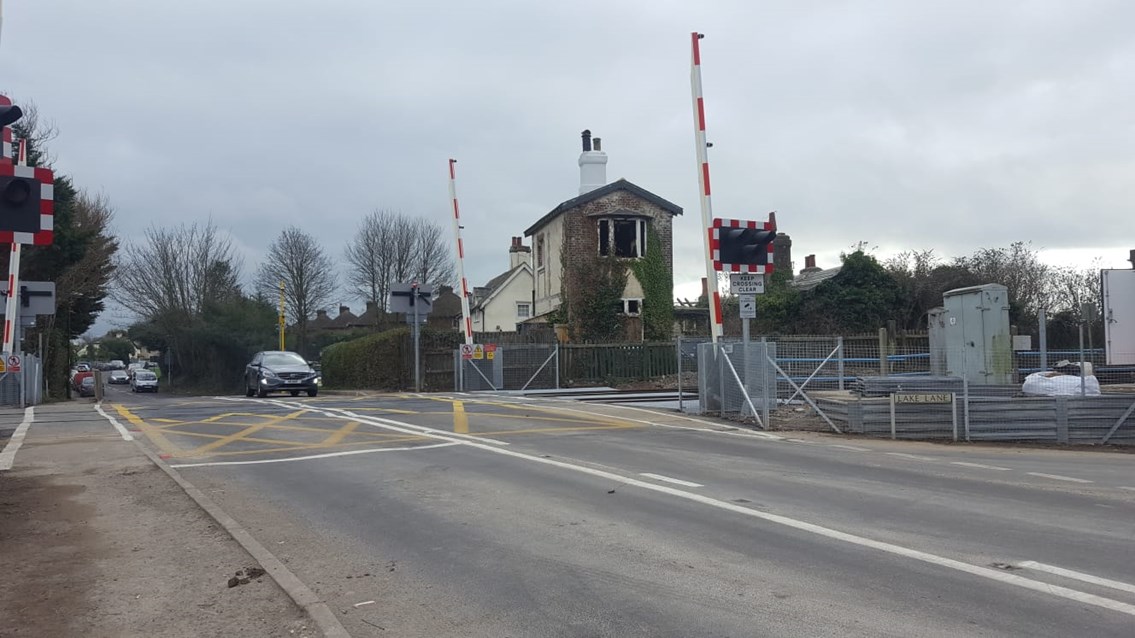Tuesday 15 Jan 2019
Major safety upgrade at one of West Sussex’s most misused level crossings successfully finished on time
- Region & Route:
- Southern
Rail passengers, motorists and pedestrians in West Sussex can look forward to safer journeys after Network Rail finished a £4m upgrade of Yapton level crossing to combat dangerous drivers.
Upgrading from an automatic half-barrier crossing to a manually controlled full-barrier crossing, will reduce the risks posed by motorists trying to jump the lights and swerve around the closing barriers.
It will also allow Network Rail to remove a six-year-long safety speed restriction, saving the industry thousands of pounds and faster and more punctual trains for passengers.
John Halsall, Network Rail’s managing director in the South East, said:
“Our work at Yapton is a great example of how a safe railway is a performing railway. By reducing the risk of deliberate driver misuse we’ve been able to allow trains to run at their full line speed for the first time in six years, meaning faster and more reliable journeys for the 300 trains that pass through every weekday.
“I’d also like to thank residents and road users in the area for their patience and understanding while we worked to upgrade the crossing. I’m confident it is now safer for everyone, whether they are rail passengers, drivers or pedestrians.”
There was 10-day road closure while the upgrade was completed, which was lifted on time in the earlier hours of Monday, 14 January.
More than 8,000 vehicles use the crossing every day with an average of 3.7 incidents, including drivers ignoring red lights, weaving around the barriers and queueing over the crossing – despite a red light enforcement camera being installed in 2017.
This meant trains were restricted to 30mph on this stretch of track, but they can now run at the full 65mph, improving punctuality and performance on the West Coastway line.
Angie Doll, Southern and Gatwick Express passenger services director, said: “Yapton level crossing had a regular, daily impact on our passengers and we’re delighted Network Rail has completed this work.”
Notes to Editors
- Following the crossing upgrade the average length of each closure sequence will increase from 59 seconds to two minutes and 48 seconds.
- At peak times and when multiple trains pass over the crossing at the same time the closure sequence could be up to 6-7 minutes.
- Network Rail installed red light enforcement cameras at the crossing in 2017 to deter dangerous driving at the crossing. While hundreds of motorists have been prosecuted for dangerous driving an average of 3.7 incidents still occur every day.
- Network Rail placed a temporary speed restriction for trains passing over the crossing in 2012, which reduces the risk of a collision between a vehicle and a train - but the speed restriction delays trains and costs the rail industry over £100,000 every year.
- Local population growth and increasing vehicle use means that the crossing would require an upgrade to a full barrier CCTV crossing by 2025 anyway.
- More than 60 motorists were caught risking their lives ignoring warning lights at Yapton level crossing in the red light enforcement camera’s first month of operation. A further 94 were caught but not prosecuted while the camera was in ‘test’ mode the month before, including a school minibus and a bus.
How does a full barrier CCTV crossing work?
- This level crossing has full barriers on both sides of the road. It is operated by a Network Rail signaller, who uses a CCTV system to control it remotely.
- When a train is coming, there is a warning amber light, followed by alternately flashing red lights. There is also a warning tone for pedestrians, cyclists and horse riders.
- When the signaller is satisfied that the crossing is completely clear, he or she will then operate the signal(s) for the train(s). Until the entire sequence is completed, the signal for the crossing will remain at red.
- If there is an obstruction on the crossing the signaller can stop the closure sequence.
- If there is no train approaching, the barriers will automatically raise after the passage of the train. The decision to keep the barriers lowered for a second, third or even fourth train depends entirely of the position of the trains. No two days are the same. Given the lowering sequence described above, the signaller will know if he or she has sufficient time to allow the barriers to raise and re-lower without delaying the following trains(s).
- https://www.networkrailmediacentre.co.uk/resources/mcb-cctv-level-crossing-safety-leaflet
Contact information
Passengers / community members
Network Rail national helpline
03457 11 41 41
Latest travel advice
Please visit National Rail Enquiries
Journalists
Paul Dent-Jones
paul.dent-jones@networkrail.co.uk
About Network Rail
We own, operate and develop Britain's railway infrastructure; that's 20,000 miles of track, 30,000 bridges, tunnels and viaducts and the thousands of signals, level crossings and stations. We run 20 of the UK's largest stations while all the others, over 2,500, are run by the country's train operating companies.
Usually, there are almost five million journeys made in the UK and over 600 freight trains run on the network. People depend on Britain's railway for their daily commute, to visit friends and loved ones and to get them home safe every day. Our role is to deliver a safe and reliable railway, so we carefully manage and deliver thousands of projects every year that form part of the multi-billion pound Railway Upgrade Plan, to grow and expand the nation's railway network to respond to the tremendous growth and demand the railway has experienced - a doubling of passenger journeys over the past 20 years.
Follow us on Twitter: @networkrail
Visit our online newsroom: www.networkrailmediacentre.co.uk

